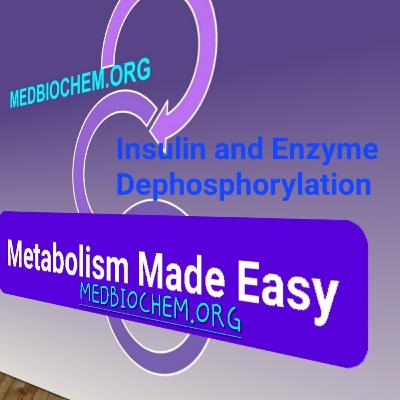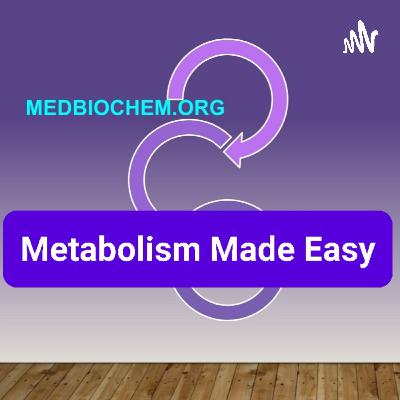Discover Metabolism Made Easy
Metabolism Made Easy

Metabolism Made Easy
Author: A J Ghalayini, Ph.D.
Subscribed: 50Played: 905Subscribe
Share
© A J Ghalayini, Ph.D.
Description
This podcast describes selected biochemistry content that could be useful to premedical/medical students.
Similar content (podcasts and videos) is available at:
https://medbiochem.org/
or check out my YouTube channel: Metabolism Made Easy
These podcasts and videos cover selected topics in medical biochemistry.
A J Ghalayini, Ph.D.
Bio for Dr. Ghalayini:
Dr. Ghalayini received his Ph.D. in Biochemistry from the University of Houston, Houston, Texas. He has over 3 decades of experience in research and medical education as professor of biochemistry at 5 different universities.
Similar content (podcasts and videos) is available at:
https://medbiochem.org/
or check out my YouTube channel: Metabolism Made Easy
These podcasts and videos cover selected topics in medical biochemistry.
A J Ghalayini, Ph.D.
Bio for Dr. Ghalayini:
Dr. Ghalayini received his Ph.D. in Biochemistry from the University of Houston, Houston, Texas. He has over 3 decades of experience in research and medical education as professor of biochemistry at 5 different universities.
193 Episodes
Reverse
This podcast describes the outcome of dephosphorylation of key enzymes trigerred by Insulin binding to its receptor and resulting in changes of both carbohydrate and lipid metabolism. Also check out my Insulin playlist on YouTube below for additional videos: INSULIN: https://www.youtube.com/playlist?list=PLXy2KYiCd9rlWs3TxwuMk26ncmzva3PM3. This biochemistry content may be useful to premedical and medical students. Similar content is available at: MEDBIOCHEM.ORG
This podcast the dependence of the brain on glucose as an energy source. Although the brain can use ketone bodies, it only does that in prolonged fasts. Instead the brain can instruct other organs to release hormones that will restore blood glucose.
This pocast covers the endocrine pancreas and the role of the beta cells in secretion of insulin. The rise in bloodstream glucose triggers the increase of glucose uptake by the pancreas by glut-2 transporter, followed by an increase in glycolysiss and a rise in ATP in the cytoplasm. This rise triggers a cascade of events inside the beta cells leading to insulin release.
This podcast covers the major glucose transporters, their tissue distribution, and regulation by hormones. The key role of these transporters is to pick up glucose from the bloodstream so it can be further metabolized by the cell.
This podcast covers 4 distinct classes of receptors and their respective hormones, including the mechanism of transducing their intracellular signals. The receptors covered in detail are the steroid receptor, the insulin receptor, and 3 distinct G-protein coupled receptors, including the second messengers they produce.
This podcast covers the use of glucose and ketone bodies as energy sources by the brain. During sleep and short fasts, the brain is completely dependent on the output of glucose by the liver. Glucose is oxidized all the way to CO2 by the brain under aerobic conditions to produce up to 38ATPs.
This podcast covers the tissue distribution of various glucose transporters and their role of glucose uptake from the bloodstream, including the regulation of one transporter (Glut-4) by insulin.
This podcast covers the salvage of Hypoxanthine, guanine and adenine by two important enzymes Hypoxanthine-guanine phosphoribosyl transferase (HGPRT) and Adeneine phosphoribosyl transferase (APRT), including the outcome of an inherited deficiency in HGPRT.
This podcast covers the essential role of glucose as an energy source for several tissues. Most notably, red blood cells and the brain. Red blood cells are entirely dependent on glucose for their energy needs while the brain is highly dependent on glucose for its energy. Glucose in the bloodstream is produced by the liver and maintained around 80-100mg/dl during fasting to provide red blood cells and the brain with their energy needs.
This episode summarizes the key effects on carbohydrate and lipid metabolism, including the processes that are activated by insulin and the ones inhibited by it.
This podcast describes 4 distinct types of enzyme inhibitors and their mechanism of inhibition, including: substrate analogues, toxins, allosteric inhibitors, and heavy metals.
This podcast covers the regulation of pyruvate kinase allosterically and by hormone-dependent (insulin & glucagon) covalent modification.
This podcast covers the metabolic changes in various organs and key organ uses of the available nutrients in the bloodstream.
With the exception of ketone bodies, the brain is entirely dependent on glucose as an energy source under most circumstances. Glucose is oxidized all the way to CO2 by the brain, producing up to 38 ATPs. This catabolism is dependent on oxygen, which is used to convert the energy in NADH and FADH2 to ATP through the Electron Transport Chain and Oxidative Phosphorylation.
This podcast covers the digestion of the major dietary fat, triacylglycerol, including digestion uptake into intestinal mucosa, delivery through the bloodstream, uptake and storage of fatty acids from chylomicrons in the bloodstream.
This podcast describes the transport of ammonia produced in peripheral tissues by incorporating it into glutamine through glutamine synthase. Glutamine is transported in the bloodstream to either the liver or kidney for further metabolism.
This podcast provides an overview of metabolic changes associated with fasting, including key metabolic changes in the liver and adipose tissue. The liver will increase its output of glucose and ketone bodies, while adipose tissue will provide fatty acids to the bloodstream for other peripheral tissues to use during fasting.
This podcast summarizes the key biochemical components of metabolism, including: 1. definition; 2. cellular location; 3. the major catabolic pathways; 4. the 3 stages of catabolism; 5. the 12 major metabolic uses of glucose, fatty acids and amino acids; 6. the energy output of catabolism of glucose, fatty acids, and ketone bodies.
This podcast covers 5 distinct enzyme regulatory mechanisms and their effects on enzyme structure and activity.
This podcast covers the function and the location of the urea cycle, including some key features and the sequence of the enzymes as well as their location.






